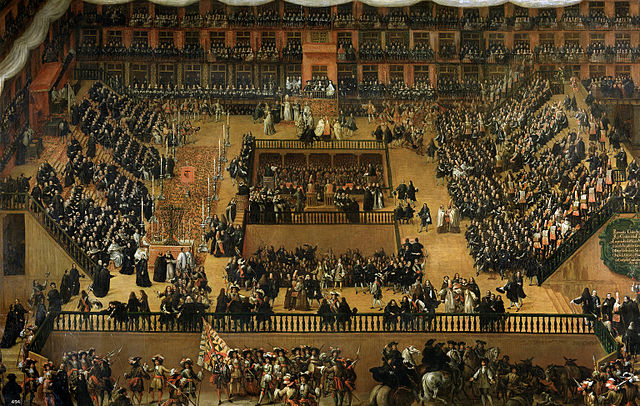An auto-da-fé was the ritual of public penance, carried out between the 15th and 19th centuries, of condemned heretics and apostates imposed by the Spanish, Portuguese, or Mexican Inquisition as punishment and enforced by civil authorities. Its most extreme form was death by burning.
Saint Dominic anachronistically presiding over an auto-da-fé, by Pedro Berruguete (around 1495)
An auto de fé in Seville, illustration from 1870
1683 painting by Francisco Rizi depicting the auto de fé held in Plaza Mayor, Madrid, in 1680.
The Tribunal of the Holy Office of the Inquisition, commonly known as the Spanish Inquisition, was established in 1478 by the Catholic Monarchs, King Ferdinand II of Aragon and Queen Isabella I of Castile. It began toward the end of the Reconquista and was intended to maintain Catholic orthodoxy in their kingdoms and to replace the Medieval Inquisition, which was under papal control. It became the most substantive of the three different manifestations of the wider Catholic Inquisition, along with the Roman Inquisition and the Portuguese Inquisition. The "Spanish Inquisition" may be defined broadly as operating in Spain and in all Spanish colonies and territories, which included the Canary Islands, the Kingdom of Naples, and all Spanish possessions in North America and South America. According to some modern estimates, around 150,000 people were prosecuted for various offences during the three-century duration of the Spanish Inquisition, of whom between 3,000 and 5,000 were executed, approximately 2.7 percent of all cases. The Inquisition, however, since the creation of the American courts, has never had jurisdiction over the indigenous. The King of Spain ordered "that the inquisitors should never proceed against the Indians, but against the old Christians and their descendants and other persons against whom in these kingdoms of Spain it is customary to proceed".

The Virgin of the Catholic Monarchs.
Bartolomé Esteban Murillo: The martyrdom of San Pedro de Arbués (1664).
Torquemada is buried in the monastery of Saint Thomas at Ávila, and left his own epitaph: “Pestem Fugat Haereticam” i.e. “drove away the pestilence of heresy".
The burning of a Dutch Anabaptist, Anneken Hendriks, who was charged with heresy in Amsterdam,1571







